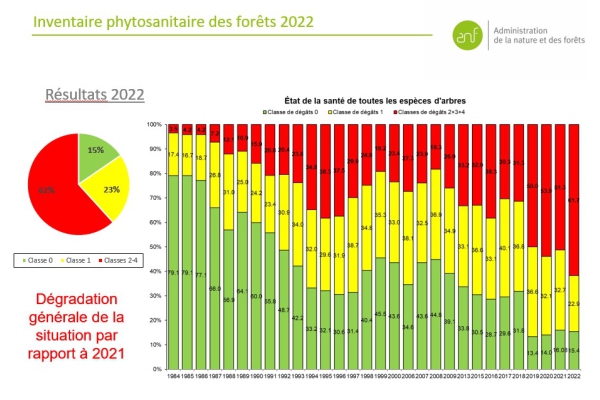 Credit: ANF
Credit: ANF
Luxembourg's Nature and Forestry Agency (Administration de la nature et des forêts - ANF) has published the 2022 edition of the phytosanitary inventory, which gives an indication of trends in the state of health of forests in Luxembourg.
This inventory has been recorded since 1984 and is based on a systematic network of sampling plots on a national scale. Regular surveys make it possible to detect the changes and impacts that have been observed in public and private forests such as which trees are the most impacted or what roles do they play in the ecosystem.
In addition, this inventory makes it possible to assess the risks arising from these new observations. The information obtained is an important basis for decisions on forestry and environmental policy.
Method
In 2022, six forestry experts analysed 1,200 trees on 51 sampling plots spread over all the forests of the Grand Duchy. The annual observation of the canopy is carried out each year at the same period (from 20 July to 15 August) and thus makes it possible to characterise the evolution of the state of health of the Luxembourg forest.
For each tree, the leaf deficit in the functional crown is estimated, ie the lack of leaves compared to the normal state of the crown of a tree full of vitality. The leaf deficit includes both the general vitality of the tree and accidental leaf loss, due for example to a one-time attack by caterpillars.
These observations allows to:
- Determine foliage condition – full leafing is 0% loss value, whilst 100% for dead trees;
- Observe the colouring of the leaves and needles of the treetops;
- Document the presence of parasites such as insects and fungi;
- Define the damage classes based on these analyses.
Evolution compared to 2021
After three comparatively too dry and too hot years, the climatic evolution of 2021 has been favourable to the forest. Bud burst in the spring of 2022 was therefore able to take place normally. However, the positive development of the year 2021 did not continue in 2022. Shortly after the appearance of the leaves, several weeks of drought marked the spring of 2022, which were followed by an exceptionally dry summer with several periods of heat waves. The deterioration therefore resumed and in particular the already weakened trees continued to be damaged, so that their phytosanitary condition further deteriorated markedly.
The proportion of forest trees clearly damaged to death increased by 10% compared to the previous year, while the proportion of sample trees without visible signs of damage decreased by 1%. The average defoliation is slightly increased. All species combined, during the summer of 2022:
- 15.40% of the trees show no damage (damage class: 0),
- 22.90% of the trees are slightly damaged (damage class: 1),
- 61.70% of the trees are clearly and / or seriously damaged (generally dying) or dead trees (damage class: 2, 3 and 4).








